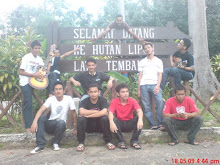Dikir barat is typically performed by groups of ten to fifteen members,[2] though there is no actual set size,[3] even in competitive environments. A group usually sits cross-legged on a platform, sometimes surrounded by the audience. Where the dikir barat is performed competitively, the two competing groups will both be on the stage at the same time.[4]
In a typical dikir barat performance, the group will perform two segments. The first is led by the tok juara,[2][5] who is often the person in charge of the musical training of the group. This first segment usually contains the more complex musical arrangements, and will likely feature the awok-awok singing in unison with the tok juara, as well as responsorial segments of singing, similar to what the tukang karut does with the awok-awok, later in the performance. Though musically more complex than what will follow, the first segment is seen as the "low-key" segment of the performance.[5]
The creative leader of a dikir barat group is the tukang karut[3]. The tukang karut is usually a former tok juara who was promoted for his talent in creating spontaneous lyrics, for it his ability to do this that establishes the reputation of the dikir barat group. Leading the awok-awok (chorus) during the second and concluding segment of the performance, the tukang karut sings pantuns—most of which are likely original and improvised on the occasion of the performance, but some which may be known to the audience.[6] (Pantuns are an oral poetry form indigenous to the Malay region, [7], and are not exclusive to the dikir barat.) That the dikir barat uses pantuns does not mean that it is a performance of poetry. The tukang karut is expected to compose lyrics that touch upon life, like any poet, but he can also address social issues, legal matters, animal lifestyles, government regulations, and human foibles. [6] The tone can be satirical, sarcastic, or simply humorous, but above all it is expected that it be clever. [2] The tukang karut makes up and sings lyrics on the topic of the performance (which may be pre-established or simply the choice of the tukang karut), and the awok-awok sings the same lyrics back to him. During the performance, members of the awok-awok clap and perform rhythmic body movements, which bring energy to the performance. [8]
Historically, dikir barat performances have been all-male. However, in recent years, especially with groups based in urban areas, female performers are beginning to appear.[4]
While most musical instruments are excluded from dikir barat, some groups to employ percussion instruments, including the rebana, maracas, or a shallow gong.[3]
The day I received my DVM
-
Assalamualaikum wbt.
Alhamdulillah. Berjaya menamatkan pelajaran setelah 5 tahun bertungkus
lumus. (bertungkus lumus kerr? :P)
Title pun dah ditukar dari ...
10 years ago






0 comments:
Post a Comment